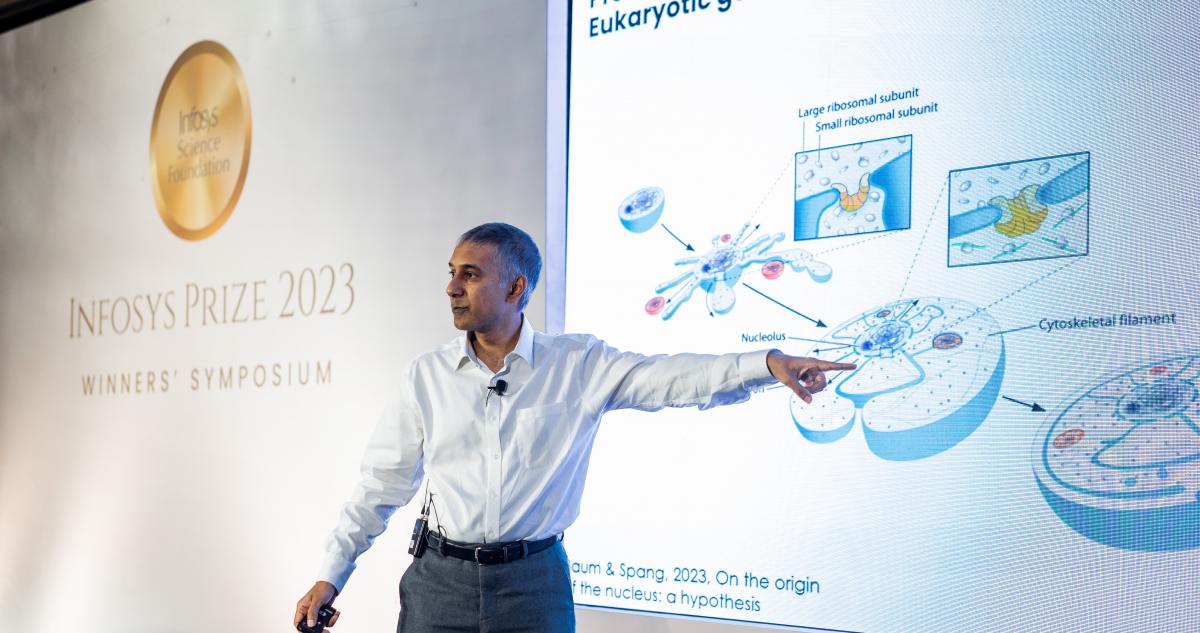 Mukund Thattai presenting at the Infosys Prize Ceremony, January 2024
Mukund Thattai presenting at the Infosys Prize Ceremony, January 2024
Image credit: Infosys Science Foundation
The convergence of physics and biology has enriched contemporary science research, even leading to new fields like evolutionary cell biology, which Professor Mukund Thattai (National Center for Biological Sciences/NCBS, India) has seen develop from its early stages. The “accidental biologist” has been one of the key contributors to this growing field over the last two decades, and his interdisciplinary work earned him the 2023 Infosys Prize.
Thattai studies how the eukaryotic cell developed its network of endomembrane organelles with many complex functions, such as transporting cargo within and out of the cell. Vesicles move molecules like proteins that are too large to pass through the cell membrane on their own. He explains that unlike the way cargo trucks are assigned routes ahead of time, within the cell, the cargo tells vesicles where to go. He found that “it’s the behavior of the proteins that ultimately define which organelles will persist and how they connect to each other.” Scientists can examine the proteins found in eukaryotes up to 1.5 billion years ago to provide insight into organelle evolution.
Like the organelles he studies, the questions that Thattai ponders today took time to evolve. During a visit home to India in his first year of grad school at MIT, Thattai went to a biology lecture, coincidentally, at NCBS. The lecture introduced him to biology in a way that fascinated him. Once he returned to MIT, he sought out courses and labs that were using the mathematical models he was familiar with to describe and accurately predict biological phenomena. Later, when he came to KITP as a Graduate Fellow in 2003 and attended the program Biomolecular Networks, he worked with KITP Permanent Member Boris Shraiman. That’s when Thattai says he “figured out the kinds of questions to start asking.”
Thattai was accepted into a new NCBS program after completing his Ph.D. He set up a lab to build genetic networks with quantitative methods, but he soon realized that he didn’t understand biology at all. With encouragement from Shraiman and his NCBS colleagues, Thattai came back to KITP in 2010 to coordinate the program Evolutionary Perspectives on Mechanisms of Cellular Organization. The coordinators wanted a crash course on cell biology, so they invited scientists working on every system within the cell they could identify. They also requested that speakers prepare to discuss evolution even if it wasn’t part of their work. “The fact that you could look at cells and ask evolutionary questions and physics questions combined—very few people were doing this.” According to Thattai, cell biologist Mark Field was the only person to give a talk on the program’s topic because it was such a novel area of interest. “Everybody came wearing a different hat because they felt free to speculate in this special place. The ability to step back from your research and have the space to talk and think in a sustained way, without any pressure to do anything else, that’s what KITP is all about.”
 Thattai’s notebook from the 2010 KITP program
Thattai’s notebook from the 2010 KITP program
Image credit: Mukund Thattai
KITP remains a special place to Thattai. “Everything I’m working on up to today was, almost literally, from questions that emerged during that program in 2010.” He even kept his notebook from the program. It is full of questions that he understands better now, and many he is still working through. His greatest aspiration is to bring an evolutionary framework to the forefront of biological questions. Advancements in genome sequencing have revealed many new organisms to study, and he is excited about the progress being made on creating artificial cells in the lab.
Thattai feels hopeful about the future of his field and biophysics more broadly. After all, he is a physicist at a biological research institution who won the Infosys Prize in the Physical Sciences category for his work in evolutionary cell biology. He believes this accomplishment sends a positive message to future generations that scientific study is not so rigid. This has been reinforced by influential publications like the National Academy of Science’s 2022 “Physics of Life,” which was the first of its kind to acknowledge this branch of physics. At NCBS, he helped establish the Simons Centre for the Study of Living Machines, as well as two biophysics courses for graduate students and postdocs. It is encouraging that this interdisciplinary approach has gained support from the scientific community through efforts like Thattai’s and his colleagues like Shraiman, who initiated and leads the Santa Barbara Advanced School of Quantitative Biology (QBio) at KITP.
Thattai feels fortunate to have experienced the strong institutional backing he found at his own NCBS, and through his time at KITP. At the core of these organizations, however, are people like Thattai whose passion and dedication move science forward.
by Demi Cain
KITP Development Coordinator
